
|
This is the LWSA pre-2017 ARCHIVE site. For 2017 and later see the current LWSA site.
2011 Weekly Rules Quiz:
Send your answer to the Fleet Captain before the start of racing each week or your boat will not be scored. Answers must involve wording along the lines of "boat Y is penalized under rule N; boat X's protest is disallowed; boat W's appeal is denied/sustained" and should include the rules used in the reasoning of the protest.
Quiz for week of 1 September 2011
Two close-hauled boats on a beat (S and P) are on a collision course. When a couple of lengths away from S, P begins bearing away to pass astern of S. S holds her course. Just as it appears to S that P is about to pass astern, P misjudges her course and collides with S, doing considerable damage to the aft port corner of S's hull and stern pulpit. S protest P and P immediately takes a Two-Turns Penalty. S, after stopping to make some repairs, manages to finish the race though she is unable to proceed at full speed due to the damage. She loses several places as a result. Ashore, S files her protest against P and also requests redress. You are on the protest committee; how would you decide this?
Note: there is no image accompanying this quiz.
Answer
Boat P is penalized uner rules 10, On Opposite Tacks, 14, Avoiding Contact and 44.1, Penalties at the Time of an Incident; and S is granted redress under rule 64.2, Decisions on Redress. By colliding with S, P failes to keep clear of S thereby breaking rule 10; and fails to avoid a collision thereby breaking rule 14. Futhermore, the collision causes serious damage to S. Therefore P is required by rule 44.1 to retire; i.e., the Two-Turns Penalty is not available when the rules breach causes serious damage. Because P does not retire, she breaks rule 44.1.
Clearly, S could not have reasonably avoided this collision; therefore she does not break rule 14. And because S's finishing place in the race is made significantly worse by the physical damage caused by P, a boat that was breaking a rule of Part 2, and because the collision occurs through no fault of her own, S is entitled to redress under rule 62.1(b), Redress.
Quiz for week of 25 August 2011
After the starting signal, Boats L and W are heading towards the anchor line of the race committee boat that marks the left end of the starting line. Both L and W have started, i.e. crossed the starting line, but neither can clear the anchor line without tacking. L hails for room to tack, but W holds her course. L luffs her sails to avoid hitting the anchor line, and W tacks away. L protests W. You are on the protest committee; how would you decide this?
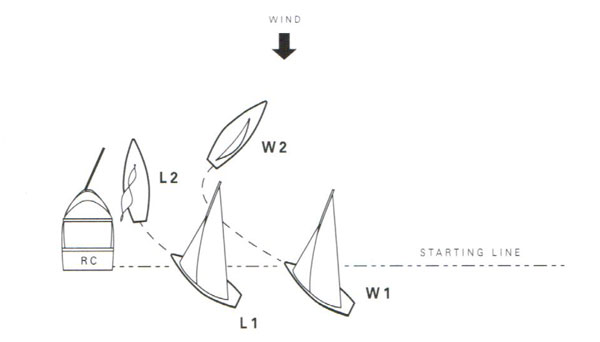
Answer
Boat L's protext is disallowed. The race committee boat's anchor line requires the boats to make substantial alterations of course to avoid it; therefore the anchor line ranks as an obstruction. Rule 20.1, Room to Tack at an Obstruction (a Section C rule) permits a leeward close-hauled boat to hail for room to tack at an obstruction. However, the preamble to Section C states, "The rules in Section C do not apply at a starting mark surrounded by navigable water or at its anchor line from the time boats are approaching them to start until they have passed them..." The race committee boat is a starting mark; and because L and W have not passed its anchor line yet, rule 20 does not apply. Therefore W is not required to respond to L's hail, nor give L room to tack.
Quiz for week of 18 August 2011
Within one hull length of a windward mark to be left to port, Boat PL (an 18-foot boat on port tack) tacks to a close-hauled course to leeward of Boat SW (on starboard tack). As PL's bow approaches the mark, SW remains close-hauled and hails to PL, "You have no rights!" As SW bears away to round the mark she forces PL to bear away into the mark to avoid hitting her. PL immediately gets clear of the other boats, hailing "Protest!" as she does, and does one turn that includes a tack and a gybe. SW sails on. After the race, PL files her protest against SW for failing to keep clear of her. You are on the protext committee; how would you decide?

Answer
Boat SW is penalized under rule 11, On the Same Tack, Overlapped. As PL approaches SW on the opposite tack, PL is required to keep clear under rule 10, On Opposite Tacks. Once PL is on a close-hauled course, she becomes the right-of-way boat (as the leeward boat), and is required by rule 15, Acquiring Right of Way, to initially give SW room to keep clear of her. Throughout the maneuver, PL never needs to take avoiding action; therefore SW keeps clear and gives room as required.
When PL completes her tack within the zone at the mark, rule 18.3(a), Mark Room: Tacking When Approaching a Mark, requires that she not cause SW to sail above close-hauled to avoid her or prevent SW from passing the mark. She did neither; therefore she did not break rule 18.3(a). Once PL is on a close-hauled course and overlapped to leeward of SW, SW (as the windward boat) becomes required to keep clear of her under rule 11. By bearing away towards PL and causing PL to take action to avoid her, SW breaks rule 11. PL choosed to take a penalty for touching the mark. This, however, does not remove her right to also protest SW. Based on the facts, SW breaks rule 11 and is penalized. The fact that PL took a One-Turn Penalty cannot be undone. However, had PL not taken a penalty, she would be exonerated by the protest committee for breaking rule 31, Touching a Mark, under rule 64.1(c), Penalties and Exoneration.
Quiz for week of 11 August 2011
Boats W and L are beam reaching along the starting line on starboard tack. Ahead of them, Boat X is nearly motionless on a close-hauled course. To avoid hitting X, W asks L for room to pass to leeward of X. L refuses, claiming that W can pass to windward of X. L passes to leeward of X and W passes to windward of X. W protests L. You are on the protest committee; how would you decide this?

Answer
Boat L is penalized for breaking rule 19.2(b), Giving Room at an Obstruction. With respect to X, both L and W are clear astern and therefor required to keep clear of her under rule 12, On the Same Tack, Not Overlapped; X therefore ranks as an obstruction to both (see definition Obstruction). As L and W approach X, L (as the right of way boat) has the option of luffing and passing X to windward, or of steering a course to pass X to leeward. When L elects to pass X to leeward, and is overlapped with W, Rule 19.2(b) requires her to give room to W, as the inside boat, to do the same. Note that had L elected to luff and pass X to windward, W would be required to keep clear under rule 11, On the Same Tack, Overlapped; and as the outside boat, to give room under rule 19.2(b).
Quiz for week of 4 August 2011
Boat Q touches the windward mark. Instead of bearing away around the mark, Q continues on a close-hauled course for a length or so, and when well clear of the other boats she promptly tacks and then gybes and continues the race. Boat T protests her for not doing a 360 degree turn after touching the mark. You are on the protest committee; how would you decide this?
Note: there is no image accompanying this quiz.
Answer
Boat T's protest is disallowed. Rules 44.1 and 44.2, Penalties at the Time of an Incident, permit a boat that has touched a mark to take a One-Turn Penalty by getting well clear of other boats as soon as possible and then promptly making one turn that includes a tack and a gybe. Boat Q properly complies with rule 44.2 and is therefore exhonerated for touching the mark.
Quiz for week of 28 July 2011
Boats PW and PL, two close-hauled port-tack boats, are half a length apart and approaching Boat S, a close-hauled starboard-tack boat. If PL and S hold their courses PL will hit S amidships. PW hails PL for room to pass astern of S. PL then hails PW for room to tack at S. PW does not respond and begins bearing away to pass astern of S. PL bears away also to avoid a collision and protests PW. In the hearing PW defends her actions by saying that she hailed first. You are on the protest committee; how would you deciede this?

Answer
Boat PW is penalized for breaking rule 20.1(b), Room to Tack at an Obstruction; Hailing and Responding. S is an obstruction to PL and PW because they both need to keep clear of S (see definition of Obstruction). Rule 19.2(b), Giving Room at an Obstruction, does not apply because the preamble to Section C states that when rule 20 applies, rule 19 does not. Rule 20 applies because safety requires the leeward boat (PL) to make a substantial course change to void an ostruction (S) and PL intends to tack. it is immaterial which boat hails first. Rule 20.1 specifically permits PL to hail PW for room to tack at an obstruction; and requires PW to respond in one of two ways (either tack or reply "you tack"). PW does neither and thereby breaks rule 20.1(b).
Quiz for week of 21 July 2011
Boat P (on port tack) and Boat S (on starboard tack), sailing close-hauled, are converging on a collision course. When three lengths apart, P bears away in order ot pass astern of S. When two lengths apart, S tacks, during which time P holds her course. After S is on a close-hauled course, P luffs to her close-hauled course to avoid hitting S, and protests S under rules 16.1 and 16.2, Changing Course, and 13, While Tacking. You are on the protest committee; how would you decide this?
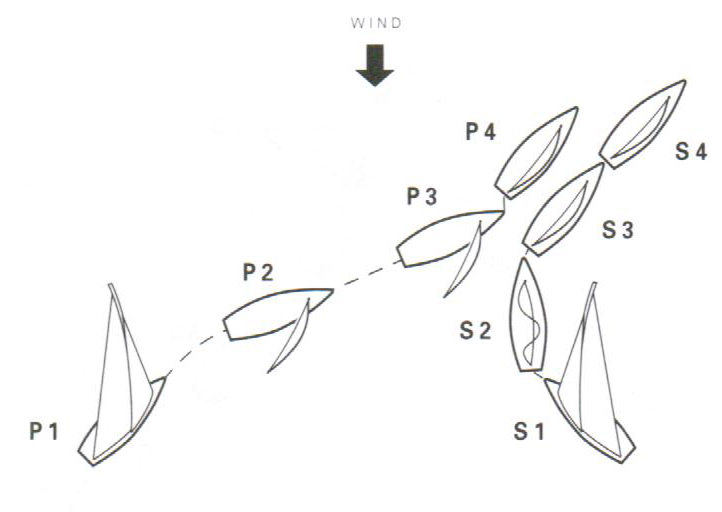
Answer
Boat P's protest is disallowed. As Boat S luffs in preparation to tacking, P does not need to change her course to cointue to keep clear of S; therefore S complies with rules 16.1 and 16.2. Similarly, while S is past head to wind but before on a close-hauled course, P does not have to change course to avoid a collision with S; therefore S complies with rule 13. After S is on a close-hauled course, i.e., completes her tack, she becomes the right-of-way boat (as the leeward boat) and P is able to keep clear of S, which she demonstrated by her actual performance. Therefore S complies with rule 15, Acquiring Right of Way, and P complies with rule 11, On the Same Tack, Overlapped. The action of P, in bearing away, does not of itself require S to maintain her course. In this case, neither boat broke a rule.
Quiz for week of 14 July 2011
Boats W and L, two overlapped starboard-tack boats, are sailing on proper courses toward the gybe mark to be rounded to port. When six lengths away from the mark, W bears away approximately 20 degrees in order to slow L, and to try to pull clear ahead before reaching the zone. L protests, claiming that W is sailing below her proper course. W claims that she is sailing on her proper course because by rounding the gybe mark ahead of L she will ultimately finish more quickly. You are on the protest committee; how would you decide this?
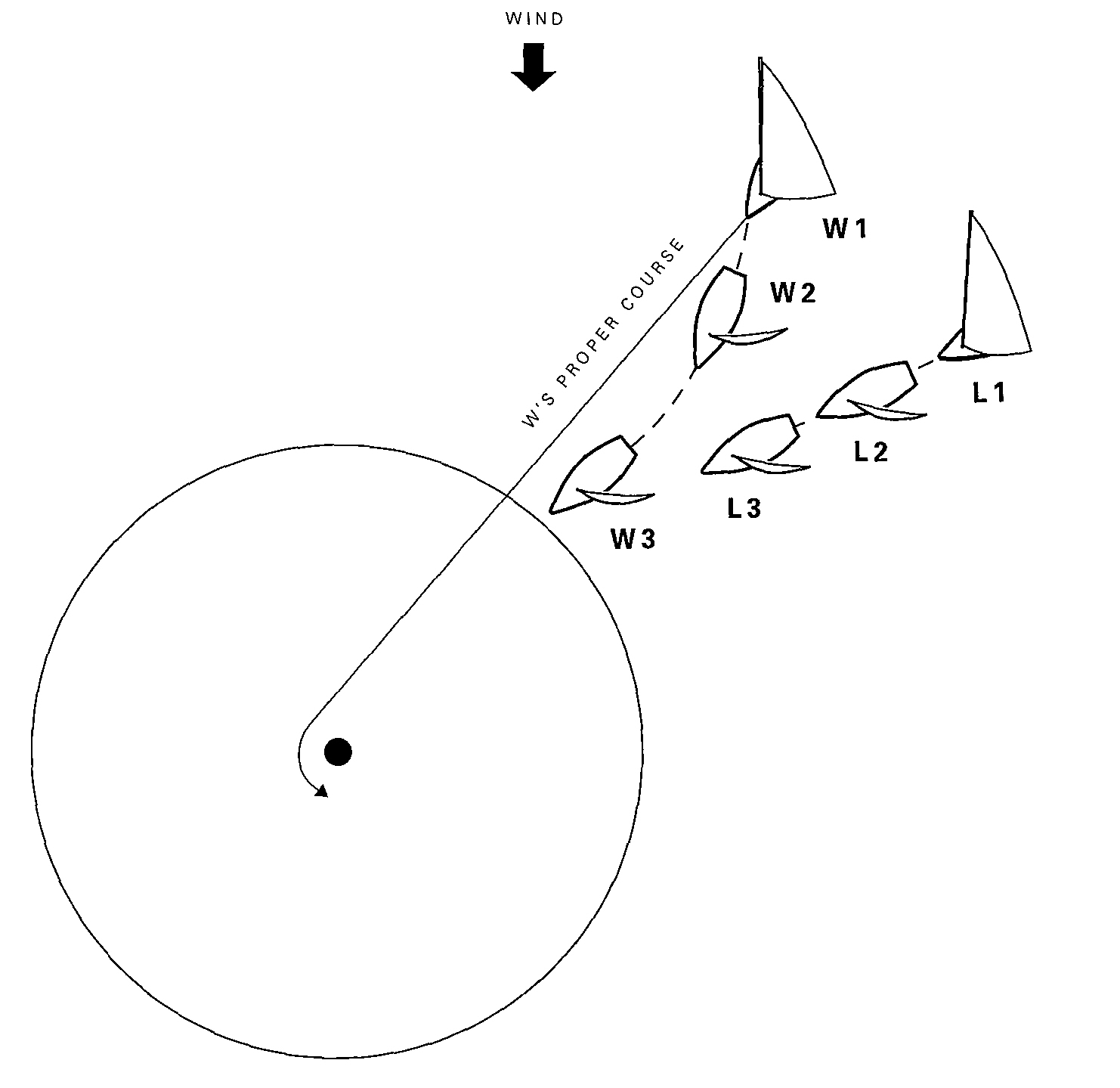
Answer
There is no rule requiring W to not sail below her proper course in this situation. While the boats are overlapped, W is required to keep clear of L under rule 11, On the Same Tack, Overlapped, which she does. Boat L's protest is disallowed.
Quiz for week of 7 July 2011
Boats W (a windward boat) and L (a leeward boat) are sailing close-hauled towards the windward mark, with W two lengths to windward of L. For tactical reasons, W wants L to tack, so W bears away 15 degrees below close-hauled, reaches onto L's wind, then luffs back up to close-hauled. L, in bad air, tacks and protests W for sailing below her proper course. You are on the protest committee; how would you decide this?

Answer
There is no rule requiring W to not sail below her proper course in this situation. While the boats are overlapped, W is required to keep clear of L under rule 11, On the Same Tack, Overlapped, which she does. Boat L's protest is disallowed.
Quiz for week of 30 June 2011
Two 18-foot boats, L (a leeward boat) and W (a windward boat), are approaching the left-hand end of the starting line, which is a 16-foot powerboat. When W is three lengths from the end of the line, L becomes overlapped on W to leeward from clear astern. There are six seconds to go before the starting signal. L slowly luffs and W keeps clear. As L reaches close-hauled, the starting signal is made. L is a boat length from the powerboat and will not clear it sailing close-hauled. She luffs to head-to-wind, shooting up and around the powerboat, and then bears away to a close-hauled course. W keeps clear throughout, and protests L for sailing above close-hauled after the starting signal. You are on the protest committee: how would you decide this?
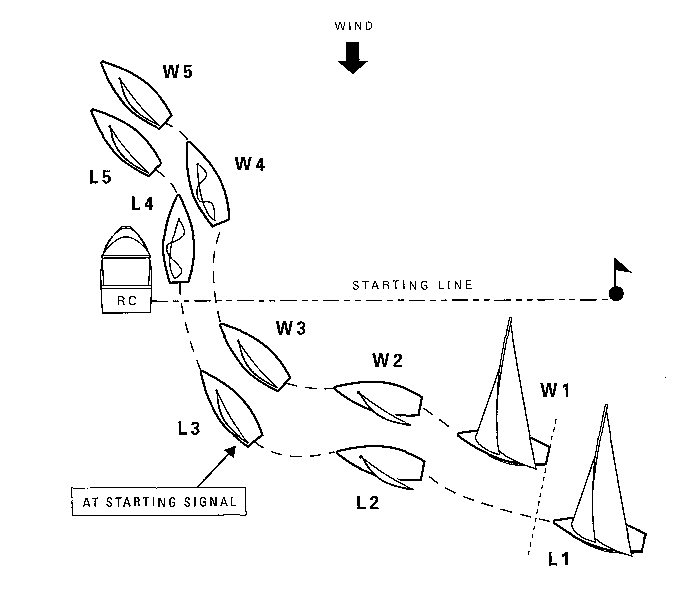
Answer
Boat W's protest is disallowed. The 16-foot powerboat ranks as both a "mark" and an "obstruction" to the 18-foot boats (see definitions Mark and Obstruction). The preamble to Section C, At Marks and Obstructions, states that rule 18 does not apply "at a starting mark surrounded by navigable water..." Therefore the situation is governed by the rules of Sections A and B. L becomes overlapped to leeward from clear astern of W therefore, rule 17, On the Same Tack; Proper Course, requires her to not sail above her proper course. Before the starting signal L has no proper course; therefore she is free to sail up to head, provided that when she changes course she gives W room to keep clear (see definition Proper Course and rule 16.1, Changing Course). After the starting signal, L is required to not sail above her proper course. In this case her "proper course" (the course she would sail to finish as soon as possible) is to luff head to wind, coast past the powerboat and then bear away to a close- hauled course (see definition Proper Course). L sails no higher than this course, and therefore does not break rule 17; and while she is changing course, L gives W room to keep clear under rule 16.1 as demonstrated by W's performance. W correctly keeps clear under rule 11, On the Same Tack, Overlapped.
Quiz for week of 23 June 2011
Boats S (on starboard tack) and P (on port tack), both close-hauled, are converging on a beat. P will safely cross S. However, when they are less than two lengths apart, the wind veers (shifts to the right) ten degrees. S luffs (changes her course) in response to the windshift, such that P is unable to keep clear. There is minor contact with no damage or injury, and both boats protest. You are on the protest committee; how would you decide this?

Answer
Answer
Boat S is penalized under rule 16.1, Changing Course. Rule 16.1 states, "When a right-of-way boat changes course, she shall give the other boat room to keep clear." S changes course when so close to P that P is unable to keep clear and there is contact. Therefore, S failed to give P room to keep clear, thereby breaking rule 16.1. S also broke rule 14, Avoiding Contact; but as the right-of-way boat, she can only be penalized under rule 14 if the contact results in damage or injury [see rule 14(b)]. P did not break rule 14, because S changed course to close to P that it was not possible for P to avoid the contact.
Quiz for week of 16 June 2011
A port-tack boat (PA) and a starboard-tack boat (SB) are approaching the windward mark. PA tacks to pass the mark, and completes her tack (i.e., arrives at a close-hauled course) within the zone. At that moment she is one length ahead and slightly to windward of SB, and moving more slowly than SB due to her tack. SB holds her course. As PA begins to bear away around the mark it becomes apparent that SB will hit PA's leeward side, and that there will not be room for SB to sail between PA and the mark without hitting either. PA luffs away from the mark and SB passes between PA and the mark with no contact. PA protests SB. You are on the protest commitee; how would you decide this?
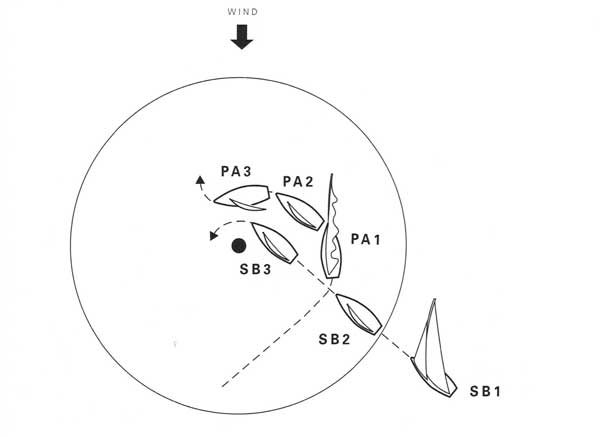
Answer
PA's protest is disallowed; neither boat broke a rule. When PA completes her tack within the zone, she does not cause SB to sail above close-hauled to avoid her, nor does she prevent her from passing the mark. Therefore PA does not break rule 18.3(a), Mark-Room: Tacking When Approaching a Mark. Rule 18.3(b) requires PA to keep clear of SB if SB becomes overlapped insider her at any time while the boats are passing the mark. By keeping clear of SB, PA complies with rule 18.3(b) and rule 11, On the Same Tack, Overlapped.
Quiz for week of 9 June 2011
With 30 seconds to go before the starting signal, Boat P (on port tack) on a beam reach, is approaching Boat S (on starboard tack) who is on a close-hauled course. P proceeds to luff and then cross head to wind all in one motion, ending up just leeward os S. Just after P passes head to wind she holds her course, telling S to keep clear because she is on starboard tack and a leeward boat. S luffs to avoid contact with P and protests. You are on the protest committee; how would you decide this?
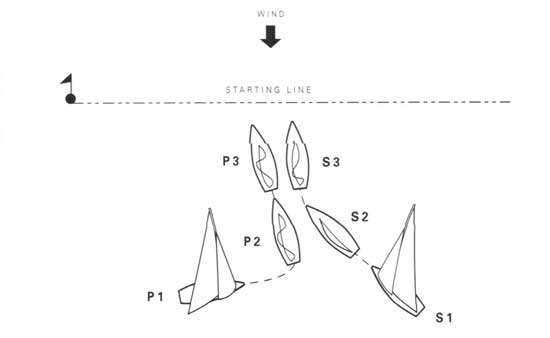
Answer
Boat P is penalized under rule 13, While Tacking. When P passes head to wind, she changes tack from port tack to starboard tack. Howeer, rule 13 states that after a boat passes head to wind, she must keep clear of other boats until she is on a close-hauled course; and before she gets to close-hauled, rules 10, 11 and 12 do not apply. Rule 11, On the Same Tack, Overlapped, is the windward/leeward rule. P has not borne away to a close-hauled course when S has to change course to avoid contact; therefore P breaks rule 13.
Quiz for week of 2 June 2011
Two starboard-tack boats, L and W, are approaching the race committee boat marking the right-hand end of the starting line to start. When there are 15 seconds before the starting signal, W overlaps L to windward from clear astern. L luffs and W is able to keep clear. The starting signal is made. With L head to wind, W does not have room to pass between L and the race committee boat. W tells L to bear away immediately to her close-hauled course, but L continues sailing head to wind thereby forcing W onto the wrong side of the race committee boat. L then bears away and starts. W circles around to start and protests L for denying her room at the starting mark by sailing above close-hauled after the starting signal. You are on the protest committee; how would you decide this?

Answer
Boat W's protest is disallowed. L, as the leeward boat, is the right-of-way boat throughout the incident under rule 11, On the Same Tack, Overlapped. When she luffs (changes course), rule 16.1, Changing Course, requires her to give W room to keep clear, which she clearly does based on W's performance. Before the starting signal, L has no limit on where she can sail; i.e., she is permitted to sail up to head to wind, even when overlaped by just a couple of feet on W.
The only rule that could potentially require L to sail no higher than her proper course after the starting signal is rule 17, On the Same Tack; Proper Course. However, rule 17 only applies when L becomes overlapped to leeward of W from clear astern. As this is not the case, rule 17 does not apply and L breaks no rule by continuing to sail head to wind after the starting signal.
Quiz for week of 26 May 2011
A port-tack boat (PL) and a starboad-tack boat (SW) are approaching the windward mark. When less than three lengths from the mark, PL tacks to leeward of SW. During the tack, SW does not have to take action to avoid contact with PL. After the tack, the two boats sail for one length at which point PL luffs head to wind to make it around the mark. To keep clear of PL, SW luffs head to wind also and there is no contact. SW protests PL. You are on the protest committee; how would you decide this?
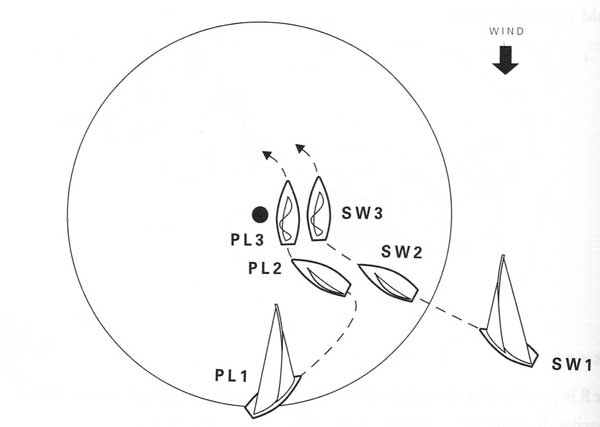
Answer
Boat PL is penalized under rule 18.3(a), Mark-Room: Tacking When Approaching a Mark. Rule 18.3(a) states, "If two boats were approaching a mark on opposite tacks and one of them changes tack, and as a result is subject to rule 13 in the zone when the other is fetching the mark... the boat that changed tack... shall not cause the other boat to sail above close-hauled to avoid her..." Rule 18, Mark-Room, applies until both boats have left the zone; therefore rule 18.3(a) continues to apply when PL luffs to make the mark. PL completes her tack within the zone, and when she luffs to make the mark she cuases SW to sail above close-hauled to avoid her, thereby breaking 18.3(a).
Quiz for week of 19 May 2011
Two 25-foot boats, L (a leeward boat) and W (a windward boat), are approaching the right-hand end of the starting line, a 30-foot powerboat, to start an upwind leg. Both boats are beam reaching, with L on a course to pass one length to leeward of the race committee boat. Twenty seconds before the starting signal and when two lengths from the race committee boat, L hails, "No room" to W. Both boats hold their courses until W is overlapped to leeward of the race committee boat. At that point L luffs and W makes contact nearly simultaneously with both L and the committee boat. There is damage to W but not serious damage. Both boats protest each other. You are on the protest committee; how would you decide this?

Answer
Boat L is penalized under rules 14, Avoiding Contact and 16.1, Changing Course. The preamble to Section C, At Marks and Obstructions, states that rule 18 does not apply "at a starting mark surrounded by navigable water or at its anchor line from the time the boats are approaching them to start..." Therefore the situation is governed by the rules in Sections A and B. At the time W becomes overlapped to leeward of the race committee boat, she is keeping clear of L in compliance with rule 11, On the Same Tack, Overlapped. Rule 16.1, Changing Course, requires L, as a right-of-way boat, to give W room to keep clear of her when she changes course. When L luffs, there is not room for W to keep clear due to the physical presence of the race committee boat. Therefore L breaks rule 16.1. Had L wished to prevent W from passing between her and the committee boat, she should have luffed sooner while W was still able to respond to her luff. L also breaks rule 14 for failing to avoid a collision; and is penalized under tha trule because the contact resulted in damage. However, from the time L began to luff, it was not possible for W to avoid contact; therefore she did not break rule 14.
Answers are based on The Racing Rules of Sailing for 2009-2012. Dave Perry's 100 Best Racing Rules Quizzes
is published by the United States Sailing Association (US SAILING). For a comprehensive explanation of the rules, read Dave Perry's Understanding the Racing Rules of Sailing 2009-2012
which is also available from US SAILING - 1 (800) 877-2451 or www.ussailing.org.

